Home / Demystifying The Mechanisms of Alcohol Oxidations
Alcohols, Epoxides and Ethers
Demystifying The Mechanisms of Alcohol Oxidations
Last updated: August 5th, 2023 |
Alcohol Oxidation Mechanisms, Demystified
• The mechanisms for the oxidation of alcohols generally involve putting a good leaving group on oxygen, followed by deprotonation of an adjacent C-H bond that results in elimination to give a new C-O pi bond.
• In this sense it greatly resembles an E2 mechanism.
• Oxidation of aldehydes to carboxylic acids usually involves addition of water to the aldehyde first (formation of a hydrate) which then undergoes elimination with base.
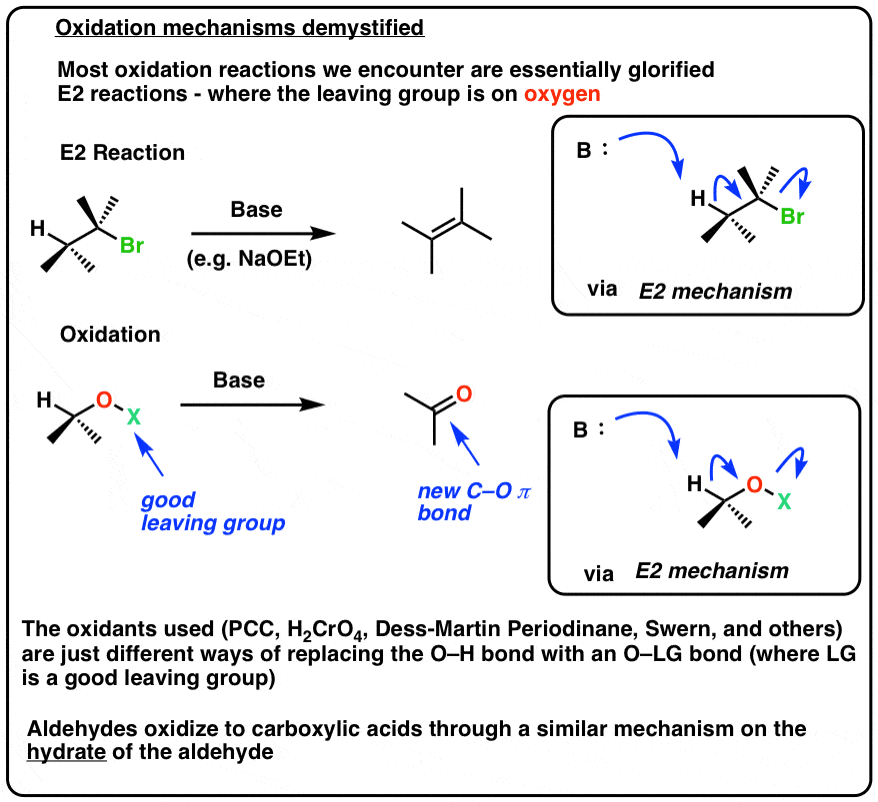
Table of Contents
- E2: The Familiar Key Step At The Heart of (Almost) All Oxidation Reactions
- Oxidants Are Essentially Fancy Reagents For Attaching Leaving Groups To Oxygen
- What About Oxidation of Aldehydes To Carboxylic Acids? (Spoiler: Yes, that too)
- Why Don’t Ketones Oxidize Further?
- Summary: Alcohol Oxidation Mechanisms
- Notes
- (Advanced) References and Further Reading
1. E2: The Familiar Key Step At The Heart Of (Almost) All Alcohol Oxidation Reactions
When I was learning organic chemistry I remember the reagents for oxidation reactions completely coming out of left field.
KMnO4, K2Cr2O7, PCC, CrO3, Swern, Dess—Martin ? Hold on. Where did these reagents come from? How do they work? Why chromium? What’s the mechanism?

In my course, the details of these reactions were completely glossed over. “ Don’t worry about the mechanism! No time to go through this! “ the instructor said. I was left with the impression that there was something deeply mysterious about alcohol oxidation.
Only later did I learn that it’s not mysterious at all. In fact the key mechanism is very familiar.
Let me show you what I mean.
Here’s a reaction we’ve seen before. Elimination of alkyl halides to give alkenes through an E2 mechanism. Base removes hydrogen, we break C-H, form C-C (π) and break C-LG. The result is an alkene.
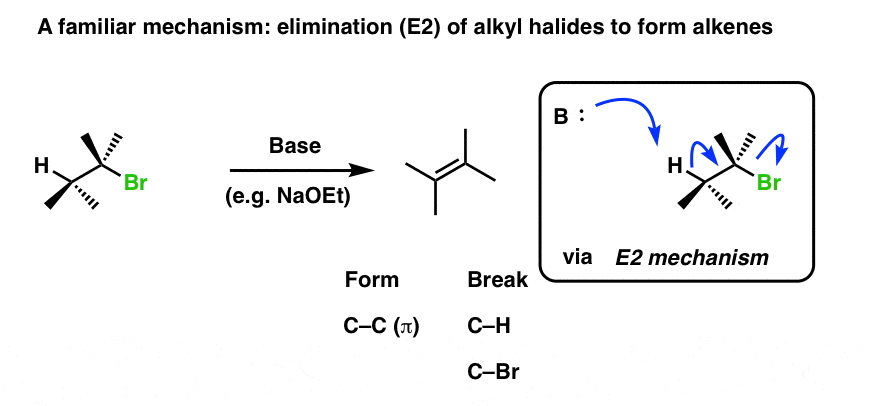
Now imagine a slightly different E2 reaction, except one where the good leaving group is on oxygen. We’ll leave it vague, as “LG” for now.
Watch!
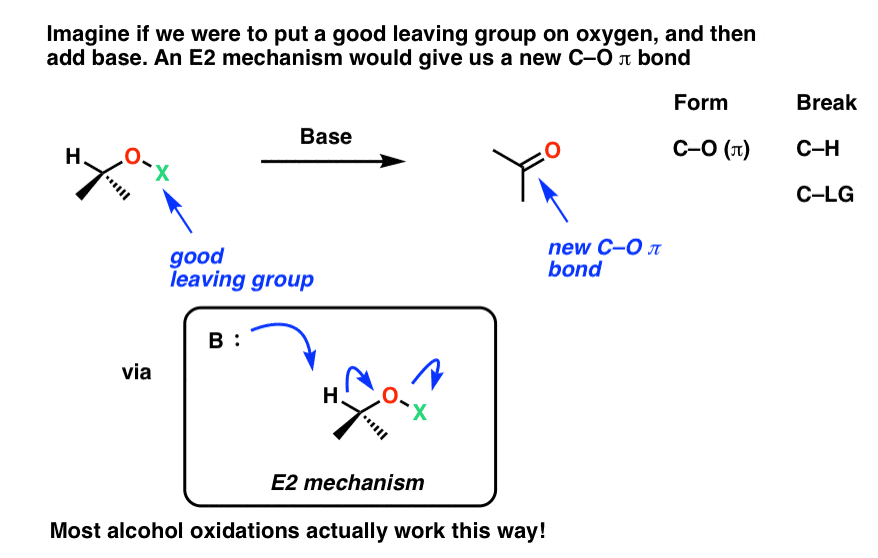
See how we break C-H, form C-O (π), and break O-LG, forming a new C-O π bond in the process. Since we’ve formed a new C-O bond at the expense of a C-H bond, an oxidation has occurred.
Believe it or not, most oxidation reactions of alcohols proceed exactly this way! [Note 1]
I wish I’d known this when I was learning organic chemistry because it would have made alcohol oxidation seem a lot less mysterious.
2. Oxidants Are Essentially Just Fancy Reagents For Attaching Good “Leaving Groups” Directly To Oxygen
Hold on, you might say. It can’t possibly be that simple. Why do we have so many different types of oxidizing agents? And why do the mechanisms (like the Jones oxidation here for example) seem so complicated?
Yes, there are a lot of steps in a typical oxidation reaction. However, most of these steps consist of:
- activating the oxidant (such as in the Swern oxidation, where oxalyl chloride converts DMSO to an electrophilic sulfur species, or in chromate oxidations, where strong acid converts chromate (such as K2Cr2O7) to the active oxidant [H2CrO4]
- coordination of the alcohol to the oxidant, followed by proton transfer(s) (seen in the mechanisms of most chromium oxidants, and Dess-Martin periodinane).
These steps are important, of course, but only in a supporting role. If you’ll excuse the analogy, they’re just foreplay that precedes the main event.
The effect of these beginning steps is simply to install a good leaving group on oxygen. That “good leaving group” can take many forms. It’s illustrated here with each oxidant, in green. There are, of course, many, many more oxidizing agents for alcohols than those depicted, but almost all of them essentially work the same way.
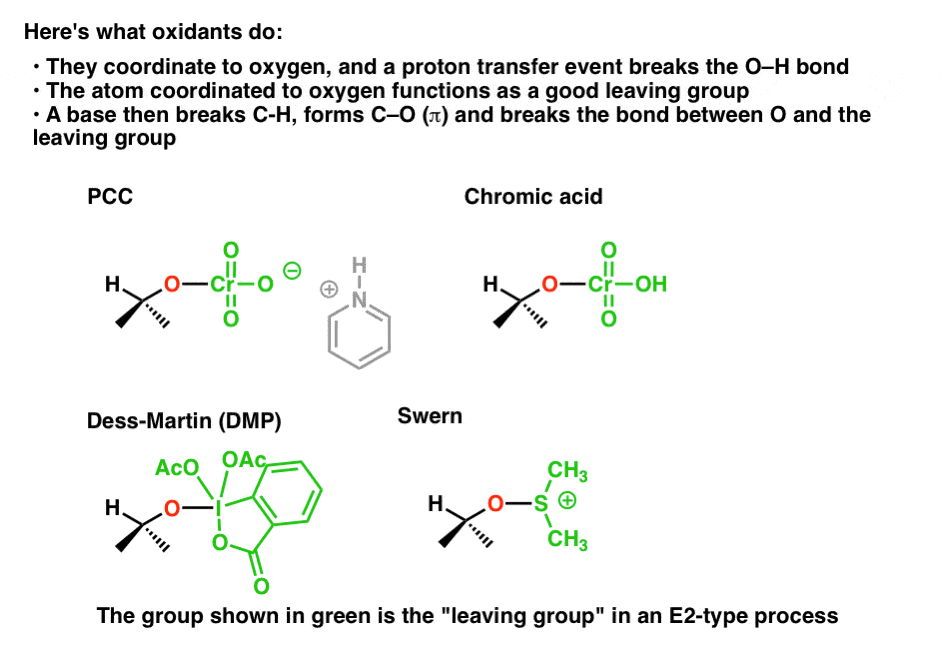
Treatment of each of these substrates with base then results in breakage of C-H, formation of C-O (π) and breakage of O-LG.
Each of these “leaving groups” accepts the pair of electrons from the bond to oxygen, reducing its oxidation state by 2 in the process. [remember – the oxidant is reduced, the substrate is oxidized]
3. What About Oxidation Of Aldehydes To Carboxylic Acids?
So if oxidation of alcohols to aldehydes and ketones is essentially an E2 reaction, how do we explain oxidation of aldehydes to carboxylic acids?
See, given what we’ve just shown, you might initially think it works something like this:

That’s actually not what happens. [Why not? Because the aldehyde carbon is a good electrophile, and any species basic enough to remove the C-H is more likely to add to the aldehyde C ]
It actually follows the same type of process as with alcohols! However, there’s a trick.
There’s a missing ingredient not mentioned in the diagram above. Water.
What happens is that water adds to the aldehyde, forming a hydrate. [If this looks unfamiliar, you’ll see MANY variations of this type of mechanism in your upcoming chapter on aldehydes and ketones. This is a sneak preview]
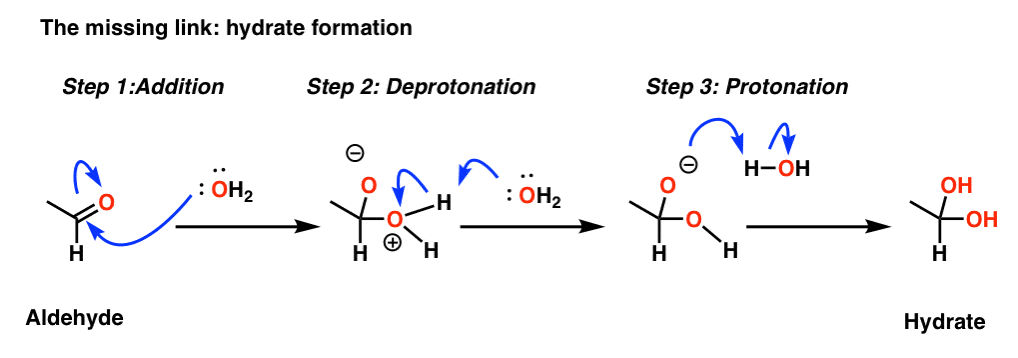
NOW, the oxidant attaches to one of the hydroxyl groups of the hydrate. The E2 from here is much easier to visualize.

This also helps to explain one key observation made tangentially in the last post. The reagent CrO3/pyridine (Collins’ reagent) will oxidize primary alcohols to aldehydes and stop there.
However, if water is present, this oxidation will go all the way to carboxylic acids. That’s because the water will form a hydrate with the aldehyde, allowing for further oxidation.
No hydrate, no further oxidation.
4. Why Don’t Ketones Oxidize Further?
This also explains why ketones don’t oxidize further. There’s no hydrogen that can be removed in an E2-type process that will lead to a new double bond!
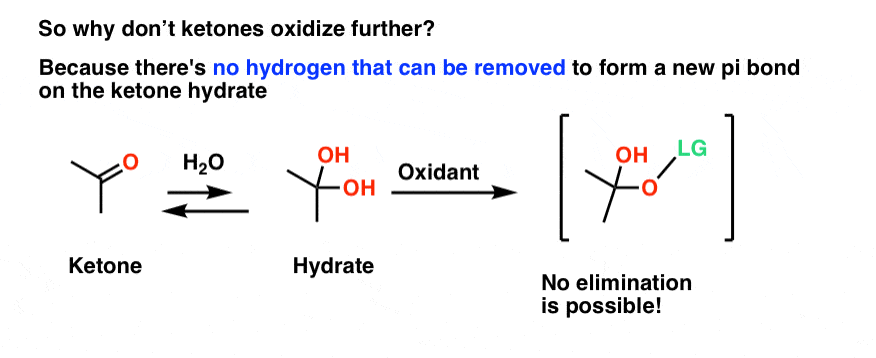
It’s similar to the old question of why this alkyl halide (below) doesn’t undergo elimination. There’s no hydrogen on the “beta” carbon (i.e. on the carbon adjacent to the carbon bearing the good leaving group) that can be removed, so no elimination occurs.

The same could be said for why tertiary alcohols don’t oxidize.
5. Summary: Alcohol Oxidation Mechanisms
So the bottom line for alcohol oxidation is the following.
- Pretty much every alcohol oxidation reaction you’ll encounter has the same key step: an E2-like deprotonation of C-H that results in formation of a new C-O pi bond and breakage of a transient leaving group.
- Aldehydes oxidize to carboxylic acids after formation of a hydrate.
- Ketones don’t oxidize further because there’s no C-H bond that can be broken that would result in a new C-O pi bond.
In the next post we’ll move to something completely different: intramolecular reactions of alcohols, a perennial subject of organic chemistry exams.
Next Post – Intramolecular Reactions Of Alcohols And Ethers
Notes
Related Articles
Note 1. The main exception you’ll encounter is KMnO4, which likely proceeds through a C-H abstraction/internal return type mechanism followed by collapse of the hydrate to give the new carbonyl. That mechanism is mentioned in exactly zero introductory textbooks, so you likely don’t “need” to know this unless you are exceptionally curious about organic chemistry. [back to post]
(Advanced) References and Further Reading
Dess-Martin Periodinane:
- A useful 12-I-5 triacetoxyperiodinane (the Dess-Martin periodinane) for the selective oxidation of primary or secondary alcohols and a variety of related 12-I-5 species
Daniel B. Dess and J. C. Martin
Journal of the American Chemical Society 1991, 113 (19), 7277-7287
DOI: 1021/ja00019a027 - Oxidation of fluoroalkyl-substituted carbinols by the Dess-Martin reagent
Russell J. Linderman and David M. Graves
The Journal of Organic Chemistry 1989, 54 (3), 661-668
DOI: 10.1021/jo00264a029
#1 is by the developers of the eponymous ‘Dess-Martin Periodinane’, a hypervalent I(V) compound that has found widespread use as a mild oxidant in organic synthesis. Prof. J. C. Martin spent most of his career at University of Illinois Urbana-Champaign and ended his career at Vanderbilt University. During his career he contributed a lot towards our understanding of hypervalent main-group chemistry, preparing many S(IV), S(VI), Br(III), I(III), I(V), and I(VII) compounds, among others. Ref #2 extends the substrate scope to fluorinated alcohols, and the use of fluorine also enables mechanistic studies of the oxidation via 19F NMR.Swern oxidation: - Structure of the dimethyl sulfoxide-oxalyl chloride reaction product. Oxidation of heteroaromatic and diverse alcohols to carbonyl compounds
Mancuso, A. J.; Brownfain, D. S.; Swern, D.
J. Org. Chem. 1979, 44 (23): 4148–4150
DOI: 10.1021/jo01337a028 - Mechanisms of dimethylsulfoxide oxidations
Kurt Torssell
Tetrahedron Letters 1966 7 (37), 4445-4451
DOI: 1016/S0040-4039(00)70057-8
These papers are on what is now commonly called the “Swern oxidation” after its developer, Daniel Swern. This method is rather mild and uses DMSO, a common solvent, as the oxidant. However, this also results in the formation of dimethyl sulfide (which is notoriously stinky) as the product of the reaction, one of its noteworthy characteristics.Corey-Kim oxidation: - New and highly effective method for the oxidation of primary and secondary alcohols to carbonyl compounds
E. J. Corey; C. U. Kim
Journal of the American Chemical Society 1972, 94 (21): 7586–7587
DOI:10.1021/ja00776a056. - A method for the oxidation of sec,tert-1,2-diols to α-hydroxy ketones without carbon-carbon cleavage
E. J. Corey; C. U. Kim
Tetrahedron Letters 1974, 15 (3): 287–290
DOI:10.1016/S0040-4039(01)82195-X
These papers by Nobel Laureate Prof. E. J. Corey (Harvard) are on the development of what is now known as the “Corey-Kim” oxidation. This is very similar to the Swern oxidation in that DMSO is used as the oxidant, except that here NCS (N-chlorosuccinimide) is used instead of oxalyl chloride. The advantage with this procedure is that temperatures above –25 °C can be used, and the disadvantage is that substrates susceptible to chlorination by NCS cannot be used.KMnO4 oxidation: - Oxidations with Manganese Dioxide
P. Papadopoulos, A. Jarrar, and C. H. Issidorides
The Journal of Organic Chemistry 1966, 31 (2), 615-616
DOI: 10.1021/jo01340a520
As this paper shows, MnO2 can also be used for oxidation of secondary alcohols. - Synthesis of a model depsipeptide segment of Luzopeptins (BBM 928), potent antitumor and antiretroviral antibiotics
Marco A. Ciufolini and Shankar Swaminathan
Tetrahedron Letters Volume 30, Issue 23, 1989, Pages 3027-3028
DOI: 1016/S0040-4039(00)99393-6
Step f in the synthesis (Scheme 1) is an oxidation of a primary alcohol to carboxylic acid using KMnO4. - Stereocontrolled addition to a penaldic acid equivalent: an asymmetric of -β-hydroxy-L-glutamic acid
Philip Garner
Tetrahedron Letters Volume 25, Issue 51, 1984, 5855-5858
DOI: 10.1016/S0040-4039(01)81703-2
The final step (g, 6 -> 7) in the synthesis in this paper is an oxidation of a primary alcohol to a carboxylic acid using KMnO4.PCC (pyridinium chlorochromate) oxidation: - Pyridinium Chlorochromate: A Versatile Oxidant in Organic Synthesis
Piancatelli, A. Scettri, M. D’Auria
Synthesis 1982; 1982(4): 245-258
DOI: 10.1055/s-1982-29766
Review on the applications of PCC in organic synthesis. Includes a discussion on the mechanism. - Kinetics and Mechanism of the Oxidation of Alcohols by Pyridinium Chlorochromate
Banerji Kalyan K.
Bull. Chem. Soc. Jpn. 1978, 51 (9), 2732
DOI: 10.1246/bcsj.51.2732
A nice mechanistic study of PCC oxidation, and includes a probable mechanism of the reaction. - Stoichiometry of the oxidation of primary alcohols with pyridinium chlorochromate. Evidence for a two-electron change
Herbert C. Brown, C. Gundu Rao, and Surendra U. Kulkarni
The Journal of Organic Chemistry 1979 44 (15), 2809-2810
DOI: 1021/jo01329a051
In this paper, Nobel Laureate H. C. Brown proves that PCC oxidations involve a transfer of 2 electrons from the Cr to the substrate. Therefore, one does not need to use an excess of PCC – 1 equivalent works fine.
The Jones oxidation, which uses chromic acid (CrO3 in H2SO4) is a common method for the oxidation of primary alcohols to carboxylic acids. The drawback is of course the production of stoichiometric amounts of chromium waste. - Researches on acetylenic compounds. Part XIV. A study of the reactions of the readily available ethynyl-ethylenic alchohol, pent-2-en-4-yn-1-ol
Sir Ian Heilbron, E. R. H. Jones and F. Sondheimer
J. Chem. Soc., 1947, 1586-1590
DOI: 10.1039/JR9470001586 - An Improved Procedure for the Oxidation of Alkynols to Alkynoic Acids
C. Holland and N. W. Gilman
Synth. Commun. 1974, 4, 203-210
DOI: 10.1080/00397917408062073Oxidation with PDC (pyridinium dichromate): - Useful procedures for the oxidation of alcohols involving pyridinium dichromate in aprotic media
E. J. Corey, Greg Schmidt
Tetrahedron Letters Volume 20, Issue 5, 1979, 399-402
DOI: 10.1016/S0040-4039(01)93515-4
Nobel Laureate Prof. E. J. Corey (Harvard) shows that PDC (pyridinium dichromate) in DMF can be used for the oxidation of primary alcohols to carboxylic acids.
00 General Chemistry Review
01 Bonding, Structure, and Resonance
- How Do We Know Methane (CH4) Is Tetrahedral?
- Hybrid Orbitals and Hybridization
- How To Determine Hybridization: A Shortcut
- Orbital Hybridization And Bond Strengths
- Sigma bonds come in six varieties: Pi bonds come in one
- A Key Skill: How to Calculate Formal Charge
- The Four Intermolecular Forces and How They Affect Boiling Points
- 3 Trends That Affect Boiling Points
- How To Use Electronegativity To Determine Electron Density (and why NOT to trust formal charge)
- Introduction to Resonance
- How To Use Curved Arrows To Interchange Resonance Forms
- Evaluating Resonance Forms (1) - The Rule of Least Charges
- How To Find The Best Resonance Structure By Applying Electronegativity
- Evaluating Resonance Structures With Negative Charges
- Evaluating Resonance Structures With Positive Charge
- Exploring Resonance: Pi-Donation
- Exploring Resonance: Pi-acceptors
- In Summary: Evaluating Resonance Structures
- Drawing Resonance Structures: 3 Common Mistakes To Avoid
- How to apply electronegativity and resonance to understand reactivity
- Bond Hybridization Practice
- Structure and Bonding Practice Quizzes
- Resonance Structures Practice
02 Acid Base Reactions
- Introduction to Acid-Base Reactions
- Acid Base Reactions In Organic Chemistry
- The Stronger The Acid, The Weaker The Conjugate Base
- Walkthrough of Acid-Base Reactions (3) - Acidity Trends
- Five Key Factors That Influence Acidity
- Acid-Base Reactions: Introducing Ka and pKa
- How to Use a pKa Table
- The pKa Table Is Your Friend
- A Handy Rule of Thumb for Acid-Base Reactions
- Acid Base Reactions Are Fast
- pKa Values Span 60 Orders Of Magnitude
- How Protonation and Deprotonation Affect Reactivity
- Acid Base Practice Problems
03 Alkanes and Nomenclature
- Meet the (Most Important) Functional Groups
- Condensed Formulas: Deciphering What the Brackets Mean
- Hidden Hydrogens, Hidden Lone Pairs, Hidden Counterions
- Don't Be Futyl, Learn The Butyls
- Primary, Secondary, Tertiary, Quaternary In Organic Chemistry
- Branching, and Its Affect On Melting and Boiling Points
- The Many, Many Ways of Drawing Butane
- Wedge And Dash Convention For Tetrahedral Carbon
- Common Mistakes in Organic Chemistry: Pentavalent Carbon
- Table of Functional Group Priorities for Nomenclature
- Summary Sheet - Alkane Nomenclature
- Organic Chemistry IUPAC Nomenclature Demystified With A Simple Puzzle Piece Approach
- Boiling Point Quizzes
- Organic Chemistry Nomenclature Quizzes
04 Conformations and Cycloalkanes
- Staggered vs Eclipsed Conformations of Ethane
- Conformational Isomers of Propane
- Newman Projection of Butane (and Gauche Conformation)
- Introduction to Cycloalkanes
- Geometric Isomers In Small Rings: Cis And Trans Cycloalkanes
- Calculation of Ring Strain In Cycloalkanes
- Cycloalkanes - Ring Strain In Cyclopropane And Cyclobutane
- Cyclohexane Conformations
- Cyclohexane Chair Conformation: An Aerial Tour
- How To Draw The Cyclohexane Chair Conformation
- The Cyclohexane Chair Flip
- The Cyclohexane Chair Flip - Energy Diagram
- Substituted Cyclohexanes - Axial vs Equatorial
- Ranking The Bulkiness Of Substituents On Cyclohexanes: "A-Values"
- Cyclohexane Chair Conformation Stability: Which One Is Lower Energy?
- Fused Rings - Cis-Decalin and Trans-Decalin
- Naming Bicyclic Compounds - Fused, Bridged, and Spiro
- Bredt's Rule (And Summary of Cycloalkanes)
- Newman Projection Practice
- Cycloalkanes Practice Problems
05 A Primer On Organic Reactions
- The Most Important Question To Ask When Learning a New Reaction
- Curved Arrows (for reactions)
- Nucleophiles and Electrophiles
- The Three Classes of Nucleophiles
- Nucleophilicity vs. Basicity
- What Makes A Good Nucleophile?
- What Makes A Good Leaving Group?
- 3 Factors That Stabilize Carbocations
- Equilibrium and Energy Relationships
- 7 Factors that stabilize negative charge in organic chemistry
- 7 Factors That Stabilize Positive Charge in Organic Chemistry
- What's a Transition State?
- Hammond's Postulate
- Learning Organic Chemistry Reactions: A Checklist (PDF)
- Introduction to Oxidative Cleavage Reactions
06 Free Radical Reactions
- Bond Dissociation Energies = Homolytic Cleavage
- Free Radical Reactions
- 3 Factors That Stabilize Free Radicals
- What Factors Destabilize Free Radicals?
- Bond Strengths And Radical Stability
- Free Radical Initiation: Why Is "Light" Or "Heat" Required?
- Initiation, Propagation, Termination
- Monochlorination Products Of Propane, Pentane, And Other Alkanes
- Selectivity In Free Radical Reactions
- Selectivity in Free Radical Reactions: Bromination vs. Chlorination
- Halogenation At Tiffany's
- Allylic Bromination
- Bonus Topic: Allylic Rearrangements
- In Summary: Free Radicals
- Synthesis (2) - Reactions of Alkanes
- Free Radicals Practice Quizzes
07 Stereochemistry and Chirality
- Types of Isomers: Constitutional Isomers, Stereoisomers, Enantiomers, and Diastereomers
- How To Draw The Enantiomer Of A Chiral Molecule
- How To Draw A Bond Rotation
- Introduction to Assigning (R) and (S): The Cahn-Ingold-Prelog Rules
- Assigning Cahn-Ingold-Prelog (CIP) Priorities (2) - The Method of Dots
- Enantiomers vs Diastereomers vs The Same? Two Methods For Solving Problems
- Assigning R/S To Newman Projections (And Converting Newman To Line Diagrams)
- How To Determine R and S Configurations On A Fischer Projection
- The Meso Trap
- Optical Rotation, Optical Activity, and Specific Rotation
- Optical Purity and Enantiomeric Excess
- What's a Racemic Mixture?
- Chiral Allenes And Chiral Axes
- Stereochemistry Practice Problems and Quizzes
08 Substitution Reactions
- Nucleophilic Substitution Reactions - Introduction
- Two Types of Nucleophilic Substitution Reactions
- The SN2 Mechanism
- Why the SN2 Reaction Is Powerful
- The SN1 Mechanism
- The Conjugate Acid Is A Better Leaving Group
- Comparing the SN1 and SN2 Reactions
- Polar Protic? Polar Aprotic? Nonpolar? All About Solvents
- Steric Hindrance is Like a Fat Goalie
- Common Blind Spot: Intramolecular Reactions
- Substitution Practice - SN1
- Substitution Practice - SN2
09 Elimination Reactions
- Elimination Reactions (1): Introduction And The Key Pattern
- Elimination Reactions (2): The Zaitsev Rule
- Elimination Reactions Are Favored By Heat
- Two Elimination Reaction Patterns
- The E1 Reaction
- The E2 Mechanism
- E1 vs E2: Comparing the E1 and E2 Reactions
- Antiperiplanar Relationships: The E2 Reaction and Cyclohexane Rings
- Bulky Bases in Elimination Reactions
- Comparing the E1 vs SN1 Reactions
- Elimination (E1) Reactions With Rearrangements
- E1cB - Elimination (Unimolecular) Conjugate Base
- Elimination (E1) Practice Problems And Solutions
- Elimination (E2) Practice Problems and Solutions
10 Rearrangements
11 SN1/SN2/E1/E2 Decision
- Identifying Where Substitution and Elimination Reactions Happen
- Deciding SN1/SN2/E1/E2 (1) - The Substrate
- Deciding SN1/SN2/E1/E2 (2) - The Nucleophile/Base
- SN1 vs E1 and SN2 vs E2 : The Temperature
- Deciding SN1/SN2/E1/E2 - The Solvent
- Wrapup: The Key Factors For Determining SN1/SN2/E1/E2
- Alkyl Halide Reaction Map And Summary
- SN1 SN2 E1 E2 Practice Problems
12 Alkene Reactions
- E and Z Notation For Alkenes (+ Cis/Trans)
- Alkene Stability
- Alkene Addition Reactions: "Regioselectivity" and "Stereoselectivity" (Syn/Anti)
- Stereoselective and Stereospecific Reactions
- Hydrohalogenation of Alkenes and Markovnikov's Rule
- Hydration of Alkenes With Aqueous Acid
- Rearrangements in Alkene Addition Reactions
- Halogenation of Alkenes and Halohydrin Formation
- Oxymercuration Demercuration of Alkenes
- Hydroboration Oxidation of Alkenes
- m-CPBA (meta-chloroperoxybenzoic acid)
- OsO4 (Osmium Tetroxide) for Dihydroxylation of Alkenes
- Palladium on Carbon (Pd/C) for Catalytic Hydrogenation of Alkenes
- Cyclopropanation of Alkenes
- A Fourth Alkene Addition Pattern - Free Radical Addition
- Alkene Reactions: Ozonolysis
- Summary: Three Key Families Of Alkene Reaction Mechanisms
- Synthesis (4) - Alkene Reaction Map, Including Alkyl Halide Reactions
- Alkene Reactions Practice Problems
13 Alkyne Reactions
- Acetylides from Alkynes, And Substitution Reactions of Acetylides
- Partial Reduction of Alkynes With Lindlar's Catalyst
- Partial Reduction of Alkynes With Na/NH3 To Obtain Trans Alkenes
- Alkyne Hydroboration With "R2BH"
- Hydration and Oxymercuration of Alkynes
- Hydrohalogenation of Alkynes
- Alkyne Halogenation: Bromination, Chlorination, and Iodination of Alkynes
- Alkyne Reactions - The "Concerted" Pathway
- Alkenes To Alkynes Via Halogenation And Elimination Reactions
- Alkynes Are A Blank Canvas
- Synthesis (5) - Reactions of Alkynes
- Alkyne Reactions Practice Problems With Answers
14 Alcohols, Epoxides and Ethers
- Alcohols - Nomenclature and Properties
- Alcohols Can Act As Acids Or Bases (And Why It Matters)
- Alcohols - Acidity and Basicity
- The Williamson Ether Synthesis
- Ethers From Alkenes, Tertiary Alkyl Halides and Alkoxymercuration
- Alcohols To Ethers via Acid Catalysis
- Cleavage Of Ethers With Acid
- Epoxides - The Outlier Of The Ether Family
- Opening of Epoxides With Acid
- Epoxide Ring Opening With Base
- Making Alkyl Halides From Alcohols
- Tosylates And Mesylates
- PBr3 and SOCl2
- Elimination Reactions of Alcohols
- Elimination of Alcohols To Alkenes With POCl3
- Alcohol Oxidation: "Strong" and "Weak" Oxidants
- Demystifying The Mechanisms of Alcohol Oxidations
- Protecting Groups For Alcohols
- Thiols And Thioethers
- Calculating the oxidation state of a carbon
- Oxidation and Reduction in Organic Chemistry
- Oxidation Ladders
- SOCl2 Mechanism For Alcohols To Alkyl Halides: SN2 versus SNi
- Alcohol Reactions Roadmap (PDF)
- Alcohol Reaction Practice Problems
- Epoxide Reaction Quizzes
- Oxidation and Reduction Practice Quizzes
15 Organometallics
- What's An Organometallic?
- Formation of Grignard and Organolithium Reagents
- Organometallics Are Strong Bases
- Reactions of Grignard Reagents
- Protecting Groups In Grignard Reactions
- Synthesis Problems Involving Grignard Reagents
- Grignard Reactions And Synthesis (2)
- Organocuprates (Gilman Reagents): How They're Made
- Gilman Reagents (Organocuprates): What They're Used For
- The Heck, Suzuki, and Olefin Metathesis Reactions (And Why They Don't Belong In Most Introductory Organic Chemistry Courses)
- Reaction Map: Reactions of Organometallics
- Grignard Practice Problems
16 Spectroscopy
- Degrees of Unsaturation (or IHD, Index of Hydrogen Deficiency)
- Conjugation And Color (+ How Bleach Works)
- Introduction To UV-Vis Spectroscopy
- UV-Vis Spectroscopy: Absorbance of Carbonyls
- UV-Vis Spectroscopy: Practice Questions
- Bond Vibrations, Infrared Spectroscopy, and the "Ball and Spring" Model
- Infrared Spectroscopy: A Quick Primer On Interpreting Spectra
- IR Spectroscopy: 4 Practice Problems
- 1H NMR: How Many Signals?
- Homotopic, Enantiotopic, Diastereotopic
- Diastereotopic Protons in 1H NMR Spectroscopy: Examples
- 13-C NMR - How Many Signals
- Liquid Gold: Pheromones In Doe Urine
- Natural Product Isolation (1) - Extraction
- Natural Product Isolation (2) - Purification Techniques, An Overview
- Structure Determination Case Study: Deer Tarsal Gland Pheromone
17 Dienes and MO Theory
- What To Expect In Organic Chemistry 2
- Are these molecules conjugated?
- Conjugation And Resonance In Organic Chemistry
- Bonding And Antibonding Pi Orbitals
- Molecular Orbitals of The Allyl Cation, Allyl Radical, and Allyl Anion
- Pi Molecular Orbitals of Butadiene
- Reactions of Dienes: 1,2 and 1,4 Addition
- Thermodynamic and Kinetic Products
- More On 1,2 and 1,4 Additions To Dienes
- s-cis and s-trans
- The Diels-Alder Reaction
- Cyclic Dienes and Dienophiles in the Diels-Alder Reaction
- Stereochemistry of the Diels-Alder Reaction
- Exo vs Endo Products In The Diels Alder: How To Tell Them Apart
- HOMO and LUMO In the Diels Alder Reaction
- Why Are Endo vs Exo Products Favored in the Diels-Alder Reaction?
- Diels-Alder Reaction: Kinetic and Thermodynamic Control
- The Retro Diels-Alder Reaction
- The Intramolecular Diels Alder Reaction
- Regiochemistry In The Diels-Alder Reaction
- The Cope and Claisen Rearrangements
- Electrocyclic Reactions
- Electrocyclic Ring Opening And Closure (2) - Six (or Eight) Pi Electrons
- Diels Alder Practice Problems
- Molecular Orbital Theory Practice
18 Aromaticity
- Introduction To Aromaticity
- Rules For Aromaticity
- Huckel's Rule: What Does 4n+2 Mean?
- Aromatic, Non-Aromatic, or Antiaromatic? Some Practice Problems
- Antiaromatic Compounds and Antiaromaticity
- The Pi Molecular Orbitals of Benzene
- The Pi Molecular Orbitals of Cyclobutadiene
- Frost Circles
- Aromaticity Practice Quizzes
19 Reactions of Aromatic Molecules
- Electrophilic Aromatic Substitution: Introduction
- Activating and Deactivating Groups In Electrophilic Aromatic Substitution
- Electrophilic Aromatic Substitution - The Mechanism
- Ortho-, Para- and Meta- Directors in Electrophilic Aromatic Substitution
- Understanding Ortho, Para, and Meta Directors
- Why are halogens ortho- para- directors?
- Disubstituted Benzenes: The Strongest Electron-Donor "Wins"
- Electrophilic Aromatic Substitutions (1) - Halogenation of Benzene
- Electrophilic Aromatic Substitutions (2) - Nitration and Sulfonation
- EAS Reactions (3) - Friedel-Crafts Acylation and Friedel-Crafts Alkylation
- Intramolecular Friedel-Crafts Reactions
- Nucleophilic Aromatic Substitution (NAS)
- Nucleophilic Aromatic Substitution (2) - The Benzyne Mechanism
- Reactions on the "Benzylic" Carbon: Bromination And Oxidation
- The Wolff-Kishner, Clemmensen, And Other Carbonyl Reductions
- More Reactions on the Aromatic Sidechain: Reduction of Nitro Groups and the Baeyer Villiger
- Aromatic Synthesis (1) - "Order Of Operations"
- Synthesis of Benzene Derivatives (2) - Polarity Reversal
- Aromatic Synthesis (3) - Sulfonyl Blocking Groups
- Birch Reduction
- Synthesis (7): Reaction Map of Benzene and Related Aromatic Compounds
- Aromatic Reactions and Synthesis Practice
- Electrophilic Aromatic Substitution Practice Problems
20 Aldehydes and Ketones
- What's The Alpha Carbon In Carbonyl Compounds?
- Nucleophilic Addition To Carbonyls
- Aldehydes and Ketones: 14 Reactions With The Same Mechanism
- Sodium Borohydride (NaBH4) Reduction of Aldehydes and Ketones
- Grignard Reagents For Addition To Aldehydes and Ketones
- Wittig Reaction
- Hydrates, Hemiacetals, and Acetals
- Imines - Properties, Formation, Reactions, and Mechanisms
- All About Enamines
- Breaking Down Carbonyl Reaction Mechanisms: Reactions of Anionic Nucleophiles (Part 2)
- Aldehydes Ketones Reaction Practice
21 Carboxylic Acid Derivatives
- Nucleophilic Acyl Substitution (With Negatively Charged Nucleophiles)
- Addition-Elimination Mechanisms With Neutral Nucleophiles (Including Acid Catalysis)
- Basic Hydrolysis of Esters - Saponification
- Transesterification
- Proton Transfer
- Fischer Esterification - Carboxylic Acid to Ester Under Acidic Conditions
- Lithium Aluminum Hydride (LiAlH4) For Reduction of Carboxylic Acid Derivatives
- LiAlH[Ot-Bu]3 For The Reduction of Acid Halides To Aldehydes
- Di-isobutyl Aluminum Hydride (DIBAL) For The Partial Reduction of Esters and Nitriles
- Amide Hydrolysis
- Thionyl Chloride (SOCl2)
- Diazomethane (CH2N2)
- Carbonyl Chemistry: Learn Six Mechanisms For the Price Of One
- Making Music With Mechanisms (PADPED)
- Carboxylic Acid Derivatives Practice Questions
22 Enols and Enolates
- Keto-Enol Tautomerism
- Enolates - Formation, Stability, and Simple Reactions
- Kinetic Versus Thermodynamic Enolates
- Aldol Addition and Condensation Reactions
- Reactions of Enols - Acid-Catalyzed Aldol, Halogenation, and Mannich Reactions
- Claisen Condensation and Dieckmann Condensation
- Decarboxylation
- The Malonic Ester and Acetoacetic Ester Synthesis
- The Michael Addition Reaction and Conjugate Addition
- The Robinson Annulation
- Haloform Reaction
- The Hell–Volhard–Zelinsky Reaction
- Enols and Enolates Practice Quizzes
23 Amines
- The Amide Functional Group: Properties, Synthesis, and Nomenclature
- Basicity of Amines And pKaH
- 5 Key Basicity Trends of Amines
- The Mesomeric Effect And Aromatic Amines
- Nucleophilicity of Amines
- Alkylation of Amines (Sucks!)
- Reductive Amination
- The Gabriel Synthesis
- Some Reactions of Azides
- The Hofmann Elimination
- The Hofmann and Curtius Rearrangements
- The Cope Elimination
- Protecting Groups for Amines - Carbamates
- The Strecker Synthesis of Amino Acids
- Introduction to Peptide Synthesis
- Reactions of Diazonium Salts: Sandmeyer and Related Reactions
- Amine Practice Questions
24 Carbohydrates
- D and L Notation For Sugars
- Pyranoses and Furanoses: Ring-Chain Tautomerism In Sugars
- What is Mutarotation?
- Reducing Sugars
- The Big Damn Post Of Carbohydrate-Related Chemistry Definitions
- The Haworth Projection
- Converting a Fischer Projection To A Haworth (And Vice Versa)
- Reactions of Sugars: Glycosylation and Protection
- The Ruff Degradation and Kiliani-Fischer Synthesis
- Isoelectric Points of Amino Acids (and How To Calculate Them)
- Carbohydrates Practice
- Amino Acid Quizzes
25 Fun and Miscellaneous
- A Gallery of Some Interesting Molecules From Nature
- Screw Organic Chemistry, I'm Just Going To Write About Cats
- On Cats, Part 1: Conformations and Configurations
- On Cats, Part 2: Cat Line Diagrams
- On Cats, Part 4: Enantiocats
- On Cats, Part 6: Stereocenters
- Organic Chemistry Is Shit
- The Organic Chemistry Behind "The Pill"
- Maybe they should call them, "Formal Wins" ?
- Why Do Organic Chemists Use Kilocalories?
- The Principle of Least Effort
- Organic Chemistry GIFS - Resonance Forms
- Reproducibility In Organic Chemistry
- What Holds The Nucleus Together?
- How Reactions Are Like Music
- Organic Chemistry and the New MCAT
26 Organic Chemistry Tips and Tricks
- Common Mistakes: Formal Charges Can Mislead
- Partial Charges Give Clues About Electron Flow
- Draw The Ugly Version First
- Organic Chemistry Study Tips: Learn the Trends
- The 8 Types of Arrows In Organic Chemistry, Explained
- Top 10 Skills To Master Before An Organic Chemistry 2 Final
- Common Mistakes with Carbonyls: Carboxylic Acids... Are Acids!
- Planning Organic Synthesis With "Reaction Maps"
- Alkene Addition Pattern #1: The "Carbocation Pathway"
- Alkene Addition Pattern #2: The "Three-Membered Ring" Pathway
- Alkene Addition Pattern #3: The "Concerted" Pathway
- Number Your Carbons!
- The 4 Major Classes of Reactions in Org 1
- How (and why) electrons flow
- Grossman's Rule
- Three Exam Tips
- A 3-Step Method For Thinking Through Synthesis Problems
- Putting It Together
- Putting Diels-Alder Products in Perspective
- The Ups and Downs of Cyclohexanes
- The Most Annoying Exceptions in Org 1 (Part 1)
- The Most Annoying Exceptions in Org 1 (Part 2)
- The Marriage May Be Bad, But the Divorce Still Costs Money
- 9 Nomenclature Conventions To Know
- Nucleophile attacks Electrophile
27 Case Studies of Successful O-Chem Students
- Success Stories: How Corina Got The The "Hard" Professor - And Got An A+ Anyway
- How Helena Aced Organic Chemistry
- From a "Drop" To B+ in Org 2 – How A Hard Working Student Turned It Around
- How Serge Aced Organic Chemistry
- Success Stories: How Zach Aced Organic Chemistry 1
- Success Stories: How Kari Went From C– to B+
- How Esther Bounced Back From a "C" To Get A's In Organic Chemistry 1 And 2
- How Tyrell Got The Highest Grade In Her Organic Chemistry Course
- This Is Why Students Use Flashcards
- Success Stories: How Stu Aced Organic Chemistry
- How John Pulled Up His Organic Chemistry Exam Grades
- Success Stories: How Nathan Aced Organic Chemistry (Without It Taking Over His Life)
- How Chris Aced Org 1 and Org 2
- Interview: How Jay Got an A+ In Organic Chemistry
- How to Do Well in Organic Chemistry: One Student's Advice
- "America's Top TA" Shares His Secrets For Teaching O-Chem
- "Organic Chemistry Is Like..." - A Few Metaphors
- How To Do Well In Organic Chemistry: Advice From A Tutor
- Guest post: "I went from being afraid of tests to actually looking forward to them".
Why do some reactant like Collins reagent stop their oxidation at the aldehyde level?
Is it just the absence of water?
Question:
If the hydrate happens BEFORE the actual attachment of the leaving group, why do we have different outcome with different leaving group?
Paragraph 2:
“2. Oxidants Are Essentially Just Fancy Reagents For Attaching Good “Leaving Groups” Directly To Oxygen”
Just fabulous
Hi, will there be a major product if a molecule with both primary and secondary alcohol is oxidized? I mean, is there a preference for oxidizing primary or secondary?
There are some reagents that will preferentially oxidize primary over secondary, and vice-versa. You usually don’t learn about such details in introductory organic, but an example of the first type (primary over secondary) is TEMPO, and an example of the second type is Bobbitt’s reagent (among others)
See this super useful handout. http://hwpi.harvard.edu/files/myers/files/6-oxidation.pdf
I was wondering if the prof could give a quick answer on NAD+ as a leaving group. Nicotinamide Adenine Dinucleotide acts as a leaving group in the same way? Probably a weak oxidant?
Thank you.
Hi!
I loved your site! You explain very well!
I have a doubt…
How can I convert secondary alcohols into aldehydes? it’s possible?
Not without breaking a C-C bond somehow.
Which book covers the KMnO4 oxidation mechanism correctly?
Good luck. It’s complicated. Start with March’s advanced organic chemistry and dig in there.
You’ve mislabeled the ketone as aldehyde in the second last diagram.
Yes – thank you, finally fixed!
Hey, I have a doubt.
Can ketones be oxidised to carboxylic acids in the presence of H2O?
Not under any conventional conditions we cover, because a C-C bond would need to break.
Non-conventionally though, and by a completely novel mechanism, methyl ketones can be oxidized to carboxylic acids in the haloform reaction. :)
Excellent post, makes a lot of things clearer even for me.
One minor observation: in the hydrate formation image, in the first reaction it looks like the water molecules attacks the C=O bond; please shift the arrow tip a bit to the left.
Will fix. Thanks for your suggestions, as always. James